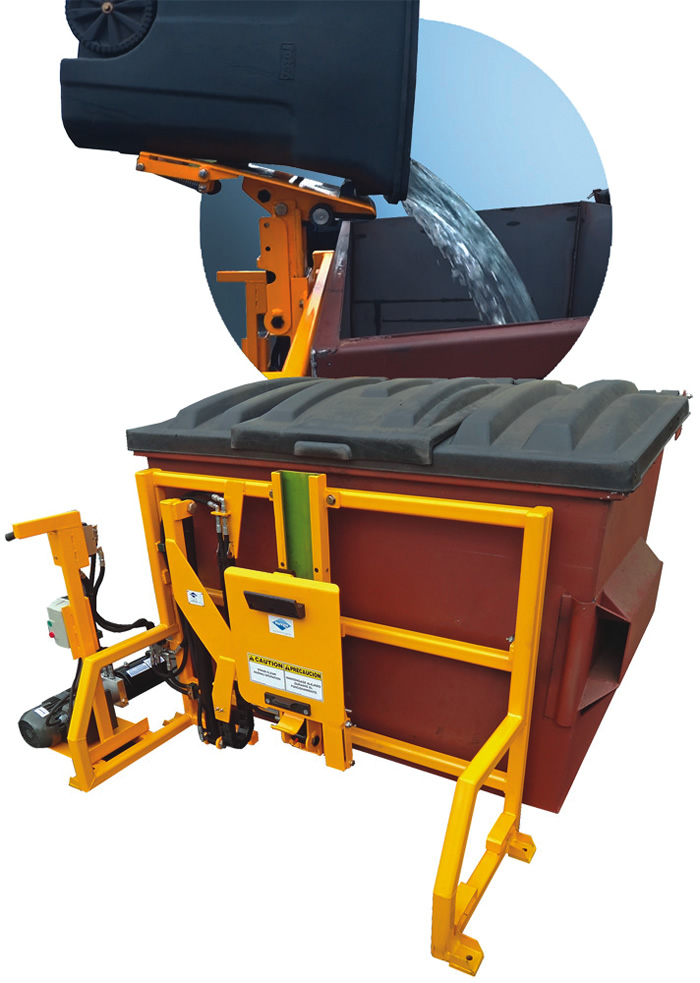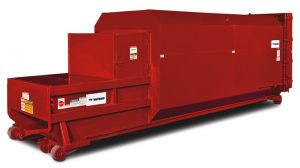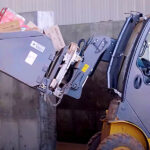Source separating food waste for diversion to composting and anaerobic digestion is in full swing, leading to innovations in equipment to service the programs.
Nora Goldstein
BioCycle July 2014
As more food waste diversion programs roll out in the residential and commercial sectors, manufacturers and suppliers are responding with new collection and container tools. The weight and moisture content of food waste have led to innovations in equipment design and operation. An increase in residential food waste collection programs — and the need to service curbside carts — are creating other opportunities for product development.
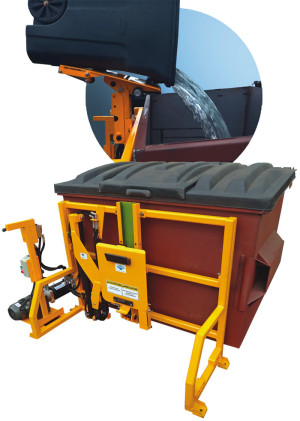
Perkins’ Food Waste Lifter slides the cart straight up over the loading edge of the container. This keeps the tilting pivot close to the cart’s center of gravity, creating a constricted rotating arc and avoiding spillage.
At WasteExpo in April 2014, vendors were showcasing new equipment specifically for food waste collection. Perkins Manufacturing Company, for example, launched its Model D6565 Food Waste Lifter “designed especially for dumping food waste,” according to the brochure. The D6565 introduces a unique “geometry” that slides the carts straight up over the loading edge of the collection container, “keeping the tilting pivot point close to the cart’s center of gravity, accomplishing a constricted rotating arc, and therefore emptying the cart without spillage,” explains Cheryl Waite, President of Perkins Manufacturing. “This is the first time we have employed this unique geometry.” The D6565 can lift up to 500 pounds, using any ANSI (American National Standards Institute) Type B cart.
Waite adds that the faceplate on the lifter was enlarged in all directions to provide more surface area for the cart to rest on and give more support to the carts. “Food waste carts are very heavy and they usually tend to rock side to side as they are being lifted,” she explains. “This can cause the bottom of the carts to deform. By enlarging the faceplate (all around), we are preventing these issues, the load remains stable as it is lifted and the carts do not get deformed.”
Another product introduction on the show floor was Wastequip’s Precision Series 265IP self-contained compactor for “ground-fed or walk-up fed” wet waste applications such as food waste. The unit’s 2 cubic yard (cy) feed hopper can be equipped with a cart lifter that is powered by the compactor itself. Compactor sizes range from 16- to 35-cy. “A grocery or big box store that generates 60 cy/week of food waste would go with one of the larger-sized units,” notes Kirk Warren, Director of Product Management in Wastequip’s Technical Products Division. “The compactor can be fed through a chute located inside the store. And because food waste is so wet and heavy, compaction with this material isn’t nearly as important as it is with dry waste.”
Warren adds that one focus of the company’s new Precision Series compactors is “user-friendliness.” This includes simpler controls with a push-button start, automatic maintenance alerts and more open space to access cylinders, rods and other components that require servicing.
Residential Collection
On the residential food waste collection side, conversations on the show floor discussed the slow but seemingly steady pace of curbside programs being rolled out in the U.S. “Everything we see in the U.S. is a crawl, walk, run approach,” notes John Sebranek, Marketing Manager, Environmental Division at Orbis Corporation. “Municipalities are starting out with pilot programs to test the waters. Anecdotally, the two main reasons we’ve seen for the pilots are: 1) They want to be sure enough infrastructure is in place to process the food waste and 2) Residents will accept the program. Communities will test curbside food waste collection in a couple of neighborhoods with different demographics. Often, because of the limited quantity of food waste collected, they can afford to send it to a processing facility further away.”
Orbis’ composting product line includes a 12-gallon Green Bin2 Organics recycling bin, and a 21-gallon size. Because many municipalities in Canada have adopted residential food waste programs, modifications to existing collection equipment and systems, as well as new product introductions, are often influenced by the experiences of Canadian municipalities. “One trend we are seeing in Canada is the desire for curbside food waste collection carts that are compatible with automated and semiautomated lifting equipment,” adds Sebranek. “Both the City of Toronto and the Region of Peel in Ontario have requested proposals from vendors for a new cart like that. Both plan to deliver them to residents in the fall of 2015. In addition, they are looking for carts to keep pests out, but unlock when dumped by an automated system.” Orbis has responded to the bids and is developing an organics cart that can be used with automated and semiautomated collection.
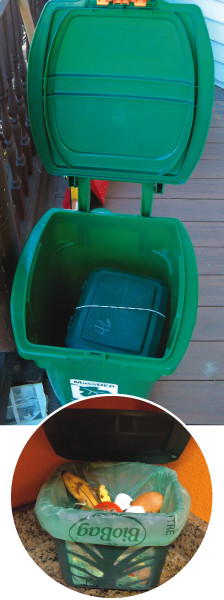
The City of Cambridge’s (MA) residential food waste collection pilot has 600 households participating. Single-family households and 2-family unit housing were given a 12-gallon Orbis Green Bin2 container, a Max Air ventilated kitchen container (inset and inside the Green Bin when delivered) and a year’s supply of BioBags.
In terms of designing programs that encourage household participation, a three-pronged approach that includes a kitchen countertop container, compostable bag liners for the containers and a curbside cart has proven successful in both pilot and full-scale programs. In April 2014, the City of Cambridge, Massachusetts initiated a curbside pilot in which 600 households are currently participating. This is phase two of a project partly funded by a grant from the Massachusetts Department of Environmental Protection. Phase one was a feasibility study. Design of the pilot also benefitted from the city’s experience running a residential food scraps drop-off program at four locations (two of the sites opened in 2008). Participation in the pilot is voluntary; single-family households as well as multiunit buildings (up to 12 units) are included. “These are households in a specific section of North Cambridge on our Monday collection route,” explains Randi Mail, Recycling Director for the City of Cambridge. “We are using an empty city packer truck to collect the food scraps.”
One lesson learned from the residential food scraps drop-off program is that compostable bag liners for the kitchen containers are “critical,” says Mail. “We didn’t introduce the drop-off program with bags, and heard complaints about the ‘yuck’ factor, rodent concerns and smells. So for the curbside pilot, we wanted to emphasize use of compostable liners to address rodents, cleanliness and odors. Over the years, we also had tried out different containers and bags in our own homes and liked the Max Air ventilated container and the BioBags. Our grant for the pilot was somewhat limited, so we sought donations from vendors to reduce some of the equipment costs. BioBag USA donated a total of 800 Max Air buckets and a year’s supply of liners for each household.”
The Max Air containers are ventilated on all sides, including the top and bottom. The BioBags, made from Novamont’s Mater-Bi® resin, are designed to breathe naturally, which, according to the manufacturer, enables moisture to evaporate. This helps to minimize odors and reduce the weight of the food scraps set out.
Resident Responses
Cambridge’s curbside pilot helps meet two of the city’s sustainability goals — a waste reduction goal of 30 percent by 2020, and 80 percent by 2050, and climate protection. “The city’s Climate Protection Plan views curbside compost as a strategy for reducing greenhouse gas emissions,” adds Mail. “And after 13 weeks of the pilot program, we’re seeing that participating households are diverting 33 percent of their trash through composting — an average of about 7 lbs/household/week. That is about an 80 percent capture rate of food scraps generated. In educational materials the City explains what to compost, but also how to reduce food waste in the first place.”
In addition to all food scraps, households can include soiled paper (napkins, paper towels, wax paper), pizza boxes and BPI-certified compostable products. Single-family households and 2-family unit housing received 12-gallon Orbis Green Bin2 curbside carts; 3-unit and up to 12-unit buildings were given one 21-gallon Orbis cart. Setout rate of the carts has been about 90 percent each week of all green bins distributed. The carts are manually unloaded into the city’s packer truck. Public Works staff surveyed pilot participants in May to get feedback on the program to date. “Over 90 percent of households are pleased with the program; only 4 households have dropped out since it started,” reports Mail. “Two-thirds of the households are producing one 13-gallon bag of trash or less per week, 50 percent say their trash weighs less and 45 percent report that their trash smells better.”
Households also provided feedback on the city’s most effective methods of outreach for the pilot. Word-of-mouth, an emailed newsletter and A-frame signs that were placed in the neighborhood were all cited as effective tools. Staff believe most residents are participating in the pilot because of the “feel-good factor,” especially related to addressing environmental concerns. “We don’t have a pay-as-you-throw program in Cambridge, so understanding why residents opt to participate is important,” adds Mail. The year-long pilot ends in March 2015.
Collected organics are composted at Rocky Hill Farm in Saugus, Massachusetts (about 90 minutes round-trip from Cambridge). Rocky Hill has two rotary drum vessels that are used for an initial composting phase (3 days at about 140°F). Next, materials are composted in windrows, followed by final curing. “The compostable bags are fully breaking down,” she notes. The tipping fee at Rocky Hill Farm is $55/ton, versus $75/ton at the solid waste transfer station used for the City of Cambridge’s trash. “We are definitely achieving avoided disposal savings, which help with the economics of residential food waste collection,” says Mail. “The hauling distance is clearly a big variable. If the round trip was 30 minutes in total, which is the distance to the transfer station, we could potentially add a lot more households.”


